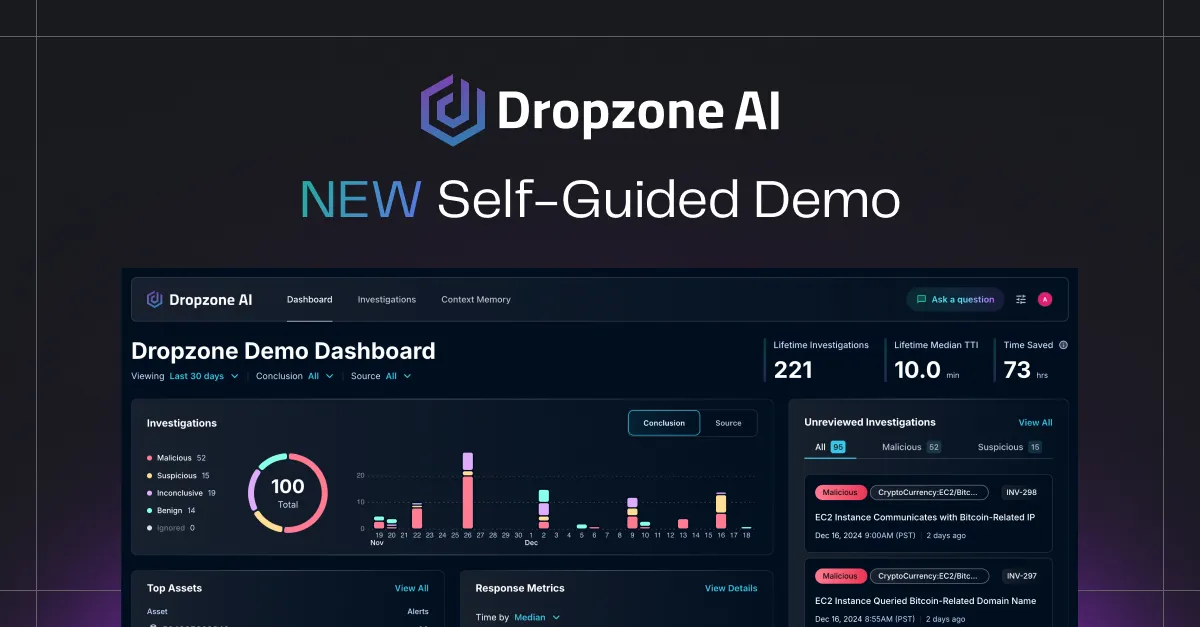What is MTTR in Cybersecurity?
Mean Time to Resolution (MTTR) represents one of the most critical performance indicators for Security Operations Centers (SOCs). It measures the complete lifecycle of threat response, from initial malicious activity to full system restoration and verification.
In the security operations context, MTTR answers a fundamental question: How quickly can your organization contain threats once they appear? According to IBM's 2024 breach report, organizations face average breach costs of $4.45 million with containment timelines stretching 277 days. Every hour of delay in resolution adds approximately $800 to incident costs, making MTTR optimization a financial imperative that can mean the difference between a minor security event and a catastrophic breach.
MTTR in security operations requires teams to ensure complete threat elimination before considering an incident resolved. A prematurely closed security incident can resurface with devastating consequences, which is why thorough investigation and verification are essential.
The Evolution of MTTR in Modern Security Operations
MTTR has evolved from a simple operational metric to a strategic business indicator. Today, with modern attacks moving at machine speed, the pressure to minimize MTTR has never been greater. Security operations must balance speed with thoroughness, ensuring rapid response without sacrificing investigation quality or leaving attack vectors unaddressed.
Why MTTR Matters More Than Ever
The acceleration of attack velocity has fundamentally changed the importance of MTTR. Modern attacks move at machine speed, with automated tools allowing attackers to compromise, escalate, and exfiltrate faster than ever before. The NotPetya malware that hit pharmaceutical giant Merck spread to 44,000 workstations in minutes. Recent attacks from groups like Scattered Spider demonstrate privilege escalation occurring within minutes of initial compromise.
Perhaps most concerning is data from Verizon's 2025 Data Breach Investigation Report showing that in 96% of analyzed incidents, victims learned about breaches from the attackers themselves, not their security tools. This suggests that while detection capabilities have improved dramatically, the ability to investigate and respond to those detections remains critically lacking. Organizations are generating more alerts than ever but struggling to translate those alerts into effective response actions.
The Compound Cost of Slow MTTR
The financial impact of poor MTTR extends far beyond direct breach costs. Every hour of active compromise creates cascading business impacts that compound over time.
Organizations face regulatory penalties when slow MTTR prevents timely breach notification and response. Meanwhile, attackers continue their activities during extended resolution times, potentially accessing more sensitive data with each passing hour.
Extended incidents damage customer trust and market confidence, requiring substantial investment to rebuild. Combined with mounting incident response costs as investigations drag on, the true cost of slow MTTR becomes clear.
For Security Operations Centers managing hundreds or thousands of daily alerts, MTTR serves as the ultimate measure of operational effectiveness. It reveals whether your security investments translate into actual threat mitigation or merely generate more uninvestigated alerts piling up in an ever-growing backlog.
How to Calculate MTTR
The Basic Formula
The standard calculation for MTTR follows the basic statistical approach:
MTTR = Total Resolution Time / Number of IncidentsFor example: 250 total hours across 10 incidents = 25-hour MTTR
However, this simple calculation masks important nuances that security teams must understand for accurate measurement and improvement.
Comprehensive Calculation Method
For accurate MTTR measurement in cybersecurity, track these critical phases:
- Initial Compromise Time: When malicious activity actually began (often determined retrospectively through forensic analysis)
- Detection Time: When security tools generated the first relevant alert
- Acknowledgment Time: When an analyst accepted the alert for investigation
- Investigation Complete: When the threat was fully understood and documented
- Containment Time: When the threat was isolated from spreading further
- Eradication Time: When all traces of the threat were removed from the environment
- Recovery Time: When systems returned to normal, secure operation
- Verification Time: When security confirmed complete threat elimination through monitoring
Practical Calculation Example
Let's walk through a real-world MTTR calculation:
- Monday 2:00 AM: Attacker gains initial access (discovered later through forensics)
- Monday 3:15 AM: SIEM generates alert for suspicious authentication
- Monday 8:30 AM: Analyst acknowledges alert and begins investigation
- Monday 10:45 AM: Investigation determines credential compromise
- Monday 11:30 AM: Account disabled, sessions terminated
- Monday 2:00 PM: Password resets, MFA enforcement completed
- Monday 4:00 PM: Verification confirms no further unauthorized access
- Total MTTR: 14 hours (from 2:00 AM to 4:00 PM)
This example highlights critical issues:
- The 5+ hour MTTA delay gave the attacker significant time to operate undetected
- Critical alerts sat unacknowledged during overnight hours
- Even after detection at 3:15 AM, the threat operated freely until 8:30 AM
Statistical Measurements for Accuracy
Relying solely on mean (average) MTTR can be dangerously misleading due to outliers. Leading SOCs track multiple statistical measures:
Mean MTTR: Overall average across all incidents. Useful for trending but easily skewed by complex breaches.
Median MTTR: The middle value when all incidents are sorted by duration. This represents your typical incident response and resists outlier influence.
95th Percentile MTTR: The value below which 95% of incidents fall. This identifies your worst-case scenarios and helps set realistic SLAs.
Components of MTTR in Security Operations
Understanding each phase of MTTR helps identify improvement opportunities and bottlenecks:
Mean Time to Detect (MTTD)
MTTD measures the gap between when malicious activity begins and when your security tools generate an alert. While not directly controllable through response processes, faster detection significantly impacts overall MTTR.
Mean Time to Acknowledge (MTTA)
Often the hidden bottleneck in MTTR, MTTA tracks how long alerts wait before investigation begins. Critical alerts might sit unacknowledged during overnight hours while threats advance unchecked. This "alert aging" problem compounds during high-volume periods when analysts triage based on perceived priority rather than actual risk.
AI-powered investigation eliminates MTTA by automatically beginning analysis upon alert generation, removing the most variable component of MTTR.
Mean Time to Investigate (MTTI)
Investigation involves gathering context from multiple tools, analyzing patterns, determining threat legitimacy, and understanding attack scope. According to Dropzone AI data, manual investigation typically requires 20-40 minutes per alert for simple cases, extending to hours for complex incidents.
Modern AI-powered investigation platforms complete thorough investigations in 3-10 minutes by automatically gathering evidence, correlating indicators across tools, and producing comprehensive reports with findings and recommendations.
Containment Through Verification
The remaining phases (containment, eradication, recovery, verification) ensure complete threat elimination and system restoration. Speed here directly impacts breach severity, as every minute of delay allows attackers to expand their foothold.
Industry MTTR Benchmarks
Understanding where your organization stands requires context from industry benchmarks:
Understanding Benchmark Variations
These dramatic disparities reflect several critical factors:
Resource Availability: Organizations with 24/7 SOC coverage achieve significantly faster MTTR than those with business-hours-only operations. The difference compounds during weekend or holiday incidents.
Tool Sophistication: Enterprises with integrated security platforms report faster MTTR than those using disparate point solutions requiring manual correlation.
Process Maturity: Organizations with documented playbooks and clear procedures achieve faster, more consistent MTTR than those relying on ad-hoc investigation.
Automation Adoption: The gap between traditional and AI-powered SOCs continues widening. Organizations using AI for initial investigation report 90% MTTR reduction for routine incidents.
Factors Affecting Your MTTR
Process Factors
Alert Management: According to the AI SOC Market Landscape 2025, the average SOC handles 960 alerts daily, with enterprises seeing 3,000+ from an average of 28 different tools. When analysts waste crucial time on false positives while real incidents wait, MTTR extends significantly. Poor alert prioritization means critical threats hide among routine noise.
Investigation Procedures: The quality and availability of investigation procedures directly impacts MTTR. Organizations need balance between standardization for common scenarios and flexibility for novel threats.
Escalation Protocols: Clear decision authority and escalation paths prevent delays during critical response moments. Every minute spent determining who can authorize containment actions extends attacker dwell time.
Technology Factors
Tool Integration Quality Poor integration between security tools forces analysts to manually correlate data across platforms. Organizations with unified platforms or AI-powered investigation tools that automatically correlate across systems see substantially faster investigation times.
Visibility Gaps Blind spots in monitoring create investigation delays and incomplete response. Without comprehensive visibility across endpoints, networks, cloud infrastructure, and applications, teams cannot fully understand or respond to threats.
Automation Level Traditional SOAR automation can reduce MTTR for routine incidents through playbook automation. However, playbook-based automation struggles with novel threats or complex investigations requiring dynamic decision-making. AI-powered investigation eliminates playbook dependency, achieving greater MTTR reduction without maintenance overhead.
Human Factors
Analyst Experience: According to SANS 2025 data, the industry faces a critical experience gap, with 70% of analysts with less than five years experience leaving within three years. This constant turnover creates knowledge loss and inconsistent MTTR performance.
Team Availability: While SANS 2025 reports that 79% of SOCs operate 24/7, coverage gaps still occur during nights, weekends, and holidays. Alert backlogs accumulate during high-volume periods or when key personnel are unavailable.
Cognitive Load and Fatigue: Analyst fatigue from processing hundreds of alerts impacts investigation quality and speed. As analysts become overwhelmed, decision quality degrades, investigation thoroughness decreases, and MTTR extends.
The Hidden Bottleneck: Understanding MTTA's Impact
While organizations invest millions in detection tools and response procedures, many overlook Mean Time to Acknowledge (MTTA) as the largest contributor to slow MTTR. MTTA represents the silent killer of security operations efficiency, the gap between alert generation and investigation initiation when threats operate unchecked.
The Alert Queue Crisis
Consider this all-too-common scenario: Your SIEM correctly identifies suspicious lateral movement at 2:00 AM Friday night. The alert joins dozens of others in the queue. The weekend crew is handling another incident. Monday morning, an analyst finally reviews the alert, now 58 hours old. During that delay, the attacker has advanced significantly through your environment.
This scenario affects most SOCs. According to ESG research cited in the AI SOC Market Landscape 2025, 44% of security alerts never receive investigation due to resource constraints. Even high-priority alerts can wait hours during busy periods or shift changes.
The Compound Effect of MTTA Delays
MTTA delays create cascading problems throughout the security operation. Related alerts from the same attack accumulate over hours or days, and by investigation time, the analyst lacks temporal context to connect events. What should be recognized as a coordinated campaign gets treated as isolated incidents.
Most critically, every hour of MTTA delay provides attackers time to advance their objectives. The longer alerts sit unacknowledged, the more opportunity attackers have to expand their foothold and achieve their goals.
The AI Solution to MTTA
AI-powered investigation eliminates the acknowledgment delay entirely through architectural transformation:
Traditional workflow: Alert → Queue → Wait → Analyst Available → Investigation Starts
AI-powered workflow: Alert → Immediate Investigation → Report Ready → Analyst Reviews
This shift reduces MTTA from hours or days to literally seconds, cutting overall MTTR by up to 80% without changing any other processes.
Strategies to Reduce MTTR
1. Implement Intelligent Automation
Modern AI-powered investigation transcends traditional automation by beginning analysis the moment alerts arrive—no queue, no waiting, no delays. AI agents query multiple tools simultaneously, collecting logs, checking user behavior, analyzing network traffic, and correlating threat intelligence in minutes rather than hours.
Unlike rigid playbooks, AI adapts investigation based on findings. The system automatically adjusts its approach based on what it discovers during investigation, ensuring every alert receives thorough analysis regardless of time, analyst availability, or workload.
This approach enables teams to handle 10x more alerts without adding headcount, fundamentally changing how SOCs operate.
2. Optimize Alert Quality
Reducing noise accelerates response across all alerts. Regular review and adjustment of detection rules minimizes false positives while maintaining detection coverage. Implement dynamic scoring that considers asset criticality, user privilege levels, and threat intelligence. Group related alerts into single incidents to prevent duplicate investigations, and suppress known benign patterns through intelligent allowlisting that considers context.
3. Streamline Response Processes
Efficient processes eliminate unnecessary delays:
Pre-Authorized Containment: Define automatic responses for confirmed threats to eliminate approval delays.
Clear Escalation Matrices: Document decision authority to prevent confusion during critical moments.
Automated Evidence Packages: Generate standardized evidence collections for common incident types.
Stakeholder Communication Templates: Pre-drafted notifications reduce communication delays during response.
4. Enhance Team Capabilities
Investing in people delivers compound returns:
Regular Tabletop Exercises: Build muscle memory and reveal process gaps through realistic scenarios.
Cross-Training Programs: Ensure coverage by training all analysts on all alert types.
Mentorship Structures: Pair junior analysts with seniors for faster skill development.
Burnout Prevention: Implement alert limits, mandatory breaks, and rotation schedules to maintain performance.
5. Improve Tool Integration
Connected tools accelerate every investigation phase:
API-First Architecture: Choose tools with robust APIs enabling automated data exchange.
Unified Investigation Platforms: Consolidate visibility into single interfaces to reduce context switching.
Automated Context Enrichment: Automatically add threat intelligence, user information, and asset details to every alert.
6. Implement Proactive Measures
Prevention reduces incident volume and complexity:
Continuous Threat Hunting: Proactive hunting identifies threats before they trigger alerts.
Attack Surface Management: Continuous discovery and reduction of exposed assets.
Security Awareness Training: Well-trained users report incidents faster with better initial information.
Vulnerability Management: Patching known vulnerabilities prevents exploitation.
MTTR Optimization with AI: Real Impact
Organizations using AI-powered investigation report significant improvements validated through purple team exercises:
- 5X reduction in MTTR during controlled testing
- $350,000+ annual risk reduction based on prevented incident escalation
- 80% reduction in Tier-1 analyst workload
- 10X increase in alert handling capacity
AI transforms each MTTR component by eliminating queue time, automating investigation, and providing complete evidence packages for confident decisions. The shift from 60-90 minute manual investigations to automated analysis represents a fundamental change in how security operations function.
Common MTTR Calculation Mistakes
Avoiding these errors ensures accurate measurement:
1. Not Including All Phases
Many organizations only measure from acknowledgment to containment, missing critical MTTA delays and verification time. True MTTR includes the complete lifecycle from detection to verified resolution.
2. Excluding After-Hours Incidents
Calculating MTTR only for business hours creates an artificially optimistic metric. Include all incidents regardless of when they occur for accurate assessment.
3. Ignoring Re-Opened Tickets
If an incident resurfaces due to incomplete remediation, the additional time must be included in MTTR calculations.
4. Missing Verification Time
Closing incidents without proper verification risks re-compromise. Always include the time required to confirm complete threat elimination.
5. Averaging Without Context
Using only mean MTTR hides performance variations. Track median and percentile metrics for complete understanding.
6. Not Segmenting by Severity
Mixing minor and critical incidents in one MTTR metric obscures performance for high-stakes responses.
MTTR vs Other Security Metrics
Understanding how MTTR relates to other metrics provides complete operational visibility:
Mean Time to Detect (MTTD)
- Measures: Time from compromise to alert generation
- Relationship: Earlier detection enables faster resolution
- Improvement focus: Better detection rules and threat intelligence
Mean Time to Acknowledge (MTTA)
- Measures: Time from alert to investigation start
- Relationship: Direct component of MTTR, often the largest delay
- Improvement focus: Automation and resource availability
Mean Time to Investigate (MTTI)
- Measures: Time to complete threat analysis
- Relationship: Core component determining response decisions
- Improvement focus: Tool integration and investigation automation
Mean Time to Contain (MTTC)
- Measures: Time to isolate the threat
- Relationship: Subset of MTTR focusing on immediate threat neutralization
- Improvement focus: Automated containment and clear procedures
Mean Time to Conclusion (MTTC - Dropzone AI metric)
- Measures: Time from suspicious activity to investigation conclusion
- Relationship: Focuses on investigation efficiency regardless of final verdict
- Improvement focus: Comprehensive investigation speed for all alerts
Note: Dropzone AI coined the term Mean Time to Conclusion (MTTC) to measure investigation efficiency across all alerts, not just confirmed incidents.
Next Steps for Improving Your MTTR
Understanding MTTR is the first step toward operational excellence. To improve your metrics:
- Baseline your current performance using the calculation methods above
- Identify bottlenecks by measuring each MTTR component
- Address MTTA first as it's typically the largest delay
- Implement intelligent automation to handle routine investigations
- Track progress weekly using mean, median, and percentile metrics
- Calculate risk exposure using the $800/hour benchmark
- Build the business case for improvement investments
Remember that every hour of MTTR improvement translates directly to reduced breach impact and lower incident costs. In an environment where attackers move at machine speed, your defense must be equally swift.
Whether establishing initial baselines or optimizing existing performance, focus on systematic improvement across people, processes, and technology. Organizations achieving world-class MTTR don't just work faster—they work smarter through intelligent automation and streamlined operations.









